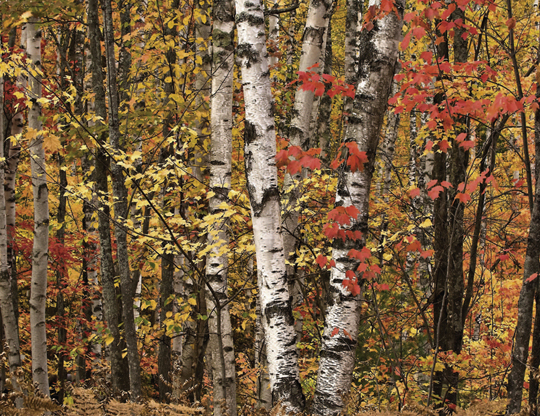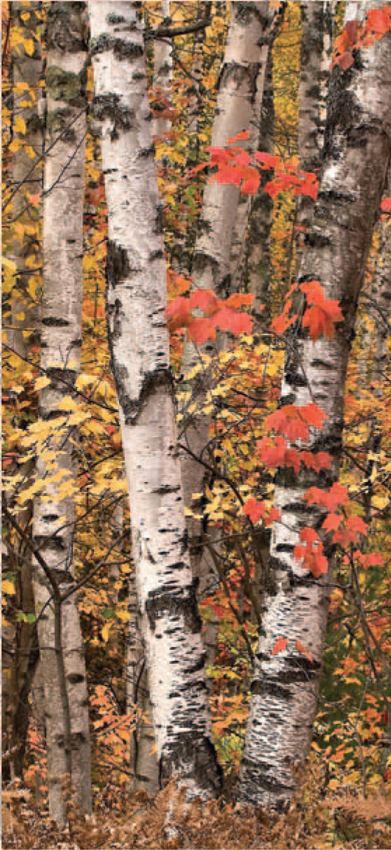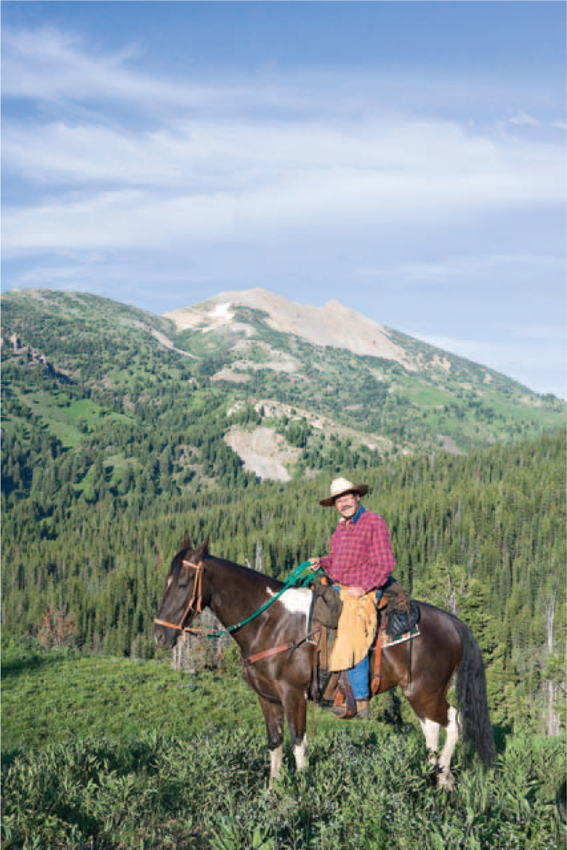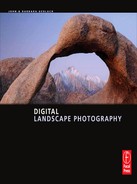Introduction

Everyone can easily find wonderful landscapes to photograph no matter where he or she lives. Even city dwellers have backyards and nearby parks where perhaps a small stream offers interesting images. Many live near an ocean, a mountain range, or a national park that was set aside to preserve scenic features. Each of these places offers the landscape photographer endless possibilities.
Landscape photographers can buy and carry less gear than other photographers, such as wildlife or macro photographers. You can do quite well with a couple of zoom lenses and a few other accessories. Two advantages landscape photographers have are the ability to approach their subject rather easily in most cases, and the ease of finding magnificent landscapes in protected and well-publicized parks.
However, natural landscapes are by no means easy to photograph well. Humans have put their mark on the landscape, too. Man-made distractions such as telephone wires, fences, litter, and signs may be difficult to keep out of your images. Even in the most remote locations, jet contrails often streak across a blue sky and smog may obscure the Grand Canyon.
Landscapes tend to be huge subjects, so natural light is crucial to getting the best images. The macro photographer’s tactics of modifying light with reflectors, diffusers, and fill flash just don’t work on a distant and massive mountain! You must be present when the best light is illuminating the landscape. This means photographing at dawn and dusk whenever possible. However, there are times when middle of the day light works well for landscapes, too.
We’ve been most fortunate to live most of our lives in northern Michigan and, since 1993, at 7000 feet in the picturesque mountains of Idaho near Yellowstone National Park. Both of these wonderful places offer fabulous landscapes to photograph. We live in the mountains to enjoy wonderful views on a daily basis, to feel and hear the storms as they crash into the mountain peaks, and to live with the mountain wildlife.
Pictured Rocks National Lakeshore’s white birch forest is absolutely stunning at peak color. Since it’s adjacent to Lake Superior at the Twelve-Mile beach campground, it peaks late during the autumn color season.

This tiny northern Michigan hillside spring is only two feet wide, but offers rich photo opportunities when autumn leaves litter the scene.

(a, b) The Lower Falls from Artist Point in Yellowstone National Park is a splendid landscape during all seasons of the year.

Some people think landscapes are static and don’t change, but they are mistaken. Landscapes change as seasons come and go. Drought or torrential rain can drastically change their appearance. Landscapes change rapidly as the light illuminating them changes. Often, fabulous light is fleeting, so you must be able to quickly and efficiently use your camera gear to capture the light before it disappears behind a cloud or drops below the horizon. The landscape is dynamic and always changing its mood.
As in our first book on digital nature photography, this book will also stress shooting the highest quality images possible in the field. We’ll do little with the digital darkroom (Capture NX, Photoshop, Aperture, Lightroom) because so many books already cover that topic and those applications. Sadly, we see too many photographers taking short-cuts, such as shooting landscapes hand-held, when it would be easy to get sharper images by using a tripod. Too many photographers are taking short-cuts because they think they can fix most problems in the digital darkroom. Perhaps they can minimize the problems later, but making wonderful landscape images is so much easier if you adopt superb shooting techniques and make them a habit. We stress these techniques throughout this book and, with practice, they will become a habit that allows you to shoot outstanding landscape images shot after shot.
However, we must explore at least a few things that you can easily do in the digital darkroom, because the power of image-editing software may significantly affect the way you shoot images in the field. Shooting a series of overlapping images so that later you can use software to stitch them together into a stunning panorama is just one important example.
Another example is the power of digital capture and high dynamic range (HDR) software to successfully record a scene that is so contrasty that it could never before be successfully photographed. HDR photography can produce truly awesome results! We’ll be discussing how to shoot an HDR scene that can be computer-assembled into an image that preserves the detail and color of the original scene’s brightest highlights and darkest shadows. We’ve devoted a whole chapter to this powerful new technique that you surely will want to use and master.
In the interest of full disclosure, I’m (John) on uneasy terms with the computer, so I know how you feel if the computer frightens you, too. I struggles with the computer more than most. If it weren’t for Barbara, who easily makes computers do her bidding, I would be absolutely lost. I have developed certain Photoshop skills, though. I’m an expert at starting the program, a guru with the crop tool, and a master at stopping for lunch — the three easiest things one can do in Photoshop. Oh, one more thing: I can convert RAW images with the Photoshop RAW converter quite well, so that must be easy, too, but I know little beyond that. Fortunately, Barbara is a whizwith computers, remembers all of the short-cut keys that make Photoshop dance to her commands, excels at making wonderful prints, and continues to expand her knowledge by practicing and attending advanced printing classes taught by master printers such as Charles Cramer.
Pristine Lake Ha Hand in the Lee Metcalf wilderness is at the edge of the alpine zone at 9000 feet. We used HDR techniques to capture color and detail in both the sunlit mountains and the heavily shadowed foreground.

We love riding horses over the mountain peaks around our Idaho home. Here’s John riding Teton, his well-behaved (usually) Tennessee Walker. We frequently use our horses to explore the wilderness where magnificent photo subjects abound.

It isn’t that I don’t want to know a lot more about the digital darkroom, but my time is critically limited. I love shooting outdoor images and teaching field workshops. Both of these interests permit me to spend massive amounts of time in wild places, which suits me perfectly. In my spare time, I do enjoy trout fishing, bird watching, kayaking, cross-country skiing, and riding Tennessee Walking Horses in the rugged mountains surrounding my home. I spend most of my time outdoors, but I do enjoy writing because it can be done at night, on rainy days, or when buckled into an airplane seat.
We never get tired of learning new ways to use cameras and lenses to shoot better images. It’s exciting to buy a new camera so all of the new features can be explored to see if they’re useful for taking better images. We meticulously go through every custom function to figure out what each one does and then carefully consider how it might help us shoot nice images. Many custom functions aren’t that useful for landscape photography, but some are critical and are covered in detail later in this book.
Our goal is to always shoot quality images because we have no use for snapshots. We hope you’re reading this book because you, too, want quality images, but don’t want to struggle with camera gear or use methods that are unnecessarily complicated or aren’t especially effective. We shoot landscapes with digital cameras quite differently than we did when shooting film. That’s why every image in this book comes from original digital capture. Although we’ve shot film all over the world for most of our careers, we feel images captured with a digital camera (not scanned slides) should be used to illustrate a book about digital photography. That’s why you won’t see any Antarctica images, even though we’ve led two photo tours before going digital to that magnificent part of the world. In some cases our recommendations differ from those of other photographers, but everyone is entitled to an opinion. Often, there’s more than one way to achieve excellent results. We explain why our shooting strategies are what they are and hope you’ll try them. Ultimately, you must decide for yourself what works best for you.
We have more than three decades of experience seriously photographing landscapes. (Could that much time have flown by?) We enjoy being productive, so we carefully choose what to photograph, because weather conditions and light are critical to making spectacular images. In addition, we’ve led hundreds of field workshops that we always strive to make successful for our students. When you have a dozen students expecting you to lead them to outstanding subjects, it adds pressure to selecting worthwhile destinations. We want our workshop students to shoot images they’ll cherish. The key to accomplishing this goal is to make sure the students have wonderful subjects to photograph in good weather and bad, and are guided in using their camera equipment in the most efficient manner they can.
This book is unlike many photography books because the emphasis is on the process of capturing outstanding images in the field. We concentrate on perfecting shooting techniques and developing strategies for dealing with the weather and light. We emphasize thoroughly working various subjects, such as fall color, waterfalls, and snow scenes. We spend a lot of time on using camera gear effectively, shooting perfect exposures, making sharp images, and creating pleasing compositions. We don’t spend much time on the digital darkroom, nor do we go into detail about how lenses focus light, the pros and cons of different imaging sensors, or the inner workings of cameras. While some of this information might be interesting to know about (or not), knowing how a lens is assembled does little to help you shoot outstanding images. We simply don’t have space in this book to cover topics that really don’t help you shoot pleasing images.
The methods we use to shoot landscape images are simple and fairly straightforward. They work for us and we know they work for the thousands of students who have attended our field workshops over the past 30 years. Our students do extremely well in our field workshops and many have gone on to make nature photography a part- or full-time activity for fun or profit. We’re thrilled by the enormous success our students have enjoyed and love seeing their images published all over the place. Once they develop superb shooting habits, learn to spot photogenic subjects, and make good decisions about where to go, given weather and light conditions, excellent landscape photography is easy to achieve.
This book is intended for those who want to learn to shoot solid and exciting landscape images efficiently, easily, and quickly. We stress the factors that really matter for achieving that goal. We wish you the best of luck in the wonderful journey that awaits you in shooting your own special landscape images. Take your time while enjoying that journey and we hope you’ll share your fine images with others!
May fabulous light lead you to magical subjects!
John and Barbara Gerlach
Natural arch in the Alabama Hills in California.

